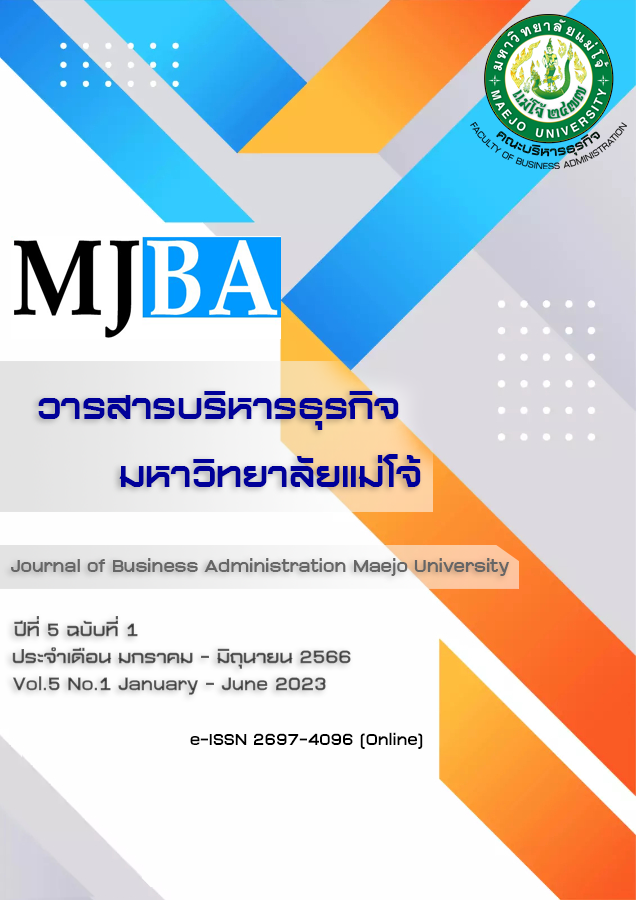อิทธิพลของการท่องเที่ยวเชิงวัฒนธรรมที่มีต่อการรับรู้คุณค่าและ แรงจูงใจในการเดินทางของนักท่องเที่ยวจังหวัดนครพนมในประเทศไทย
DOI:
https://doi.org/10.14456/mjba.2023.9คำสำคัญ:
การท่องเที่ยวเชิงศาสนา, การรับรู้คุณค่า, การส่งเสริมการท่องเที่ยว, แรงจูงใจในการเดินทางนักท่องเที่ยวจังหวัดนครพนมบทคัดย่อ
การท่องเที่ยวเชิงวัฒนธรรมมีส่วนแบ่งการท่องเที่ยวที่มีขนาดใหญ่ที่สุดและมีการเจริญเติบโตอย่างรวดเร็วสูงสุดในตลาดการท่องเที่ยวโลก การวิจัยนี้มีวัตถุประสงค์เพื่อทดสอบอิทธิพลของการท่องเที่ยวเชิงวัฒนธรรมที่มีต่อการรับรู้คุณค่าและแรงจูงใจในการเดินทางของนักท่องเที่ยวจังหวัดนครพนมในประเทศไทย นอกจากนี้ การส่งเสริมการท่องเที่ยวก็ยังถูกตั้งสมมติฐานว่าเป็นตัวแปรแทรกของความสัมพันธ์ในการวิจัย ซึ่งนักท่องเที่ยวจังหวัดนครพนมในประเทศไทย จำนวน 400 คนเป็นกลุ่มตัวอย่างที่ใช้ในการวิจัย และใช้การวิเคราะห์โมเดลสมการโครงสร้างและการวิเคราะห์การถดถอยแบบพหุคูณในการทดสอบอิทธิพล ผลลัพธ์การวิจัย พบว่า การท่องเที่ยวเชิงวัฒนธรรมมีอิทธิพลที่สำคัญเชิงบวกต่อการรับรู้คุณค่าและแรงจูงใจในการเดินทาง และการรับรู้คุณค่ามีอิทธิพลที่สำคัญเชิงบวกต่อแรงจูงใจในการเดินทางและเป็นตัวแปรกลางของความสัมพันธ์ในการวิจัยนี้ด้วย นอกจากนี้ การส่งเสริมการท่องเที่ยวเป็นตัวแปรแทรกของความสัมพันธ์ในการวิจัย ดังนั้น การท่องเที่ยวเชิงวัฒนธรรมอย่างยั่งยืนจึงมีความสำคัญและกลายเป็นแหล่งสาเหตุหลักของธุรกิจและการจ้างงานในเศรษฐกิจวันนี้ ซึ่งสามารถเพิ่มศักยภาพทางการแข่งขัน สร้างสรรค์โอกาสในการจ้างงาน ควบคุมการอพยพจากชนบท ก่อให้เกิดรายได้จากการลงทุนในการรักษาวัฒนธรรมไว้ และทะนุบำรุงความภาคภูมิใจและความหยิ่งในศักดิ์ศรีของตนเองของชุมชนวัฒนธรรม
เอกสารอ้างอิง
Adams, K., Snyder, J., Crooks, V., & Johnston, R. (2015). Tourism discourse and medical tourists’ motivations to travel. Tourism Review, 70(2), 85-96.
Allaberganov, A. & Preko, A. (2022). Inbound international tourists’ demographics and travel motives: Views from Uzbekistan. Journal of Hospitality and Tourism Insights, 5(1), 99-115.
Anderson, J. C. & Gerbing, D. W. (1988). Structural equation modeling in practice: A review and recommend two-step approach. Psychology Bulletin, 103(3), 411-423.
Anderson, W. (2015). Cultural tourism and poverty alleviation in rural Kilimanjaro, Tanzania. Journal of Tourism and Cultural Change, 13(3), 208-224.
Awang, Z. (2014). A Handbook on Structural Equation Modeling for Academicians and Practitioner (1st ed.), MPWA Rich Resources.
Bunghez, C. L. & Stefanescu, V. (2017). Cultural tourism. Revista Economica, 69(1), 29-41.
Florido-Benìtez, L. (2022). The impact of tourism promotion in tourist destinations: A bibliometric study. International Journal of Tourism Cities, 8(4), 844-882.
Galí-Espelt, N. (2012). Identifying cultural tourism: A theoretical methodological approach. Journal of Heritage Tourism, 7(1), 45-58.
Hair, J. F., Black, W. C., Babin, B. J., & Anderson, R. E. (2010). Multivariate Data Analysis: A Global Perspective (7th ed.), Person Prentice Hall.
Hausmann, A. (2007). Cultural tourism: Marketing challenges and opportunities for German cultural heritage. International Journal of Heritage Studies, 13(2), 170-184.
Hennigs, N., Wiedmann, K., Klarmann, C., & Behrens, S. (2015). The complexity of Value in the luxury industry: From consumers’ individual value perception to luxury consumption. International Journal of Retail and Distribution Management, 43(10/11), 922-939.
Huang, C., Chen, H. & Ting, C. (2017). Using a network data envelopment analysis model to assess the efficiency and effectiveness of cultural tourism promotion in Taiwan. Journal of Travel and Tourism Marketing, 34(9), 1274-1284.
Huang, S. & Hsu, C. H. C. (2009). Travel motivation: Linking theory to practice. International Journal of Culture, Tourism and Hospitality Research, 3(4), 297-295.
Kherbouche, S. & Djedid, A. (2019). Promoting the image of historic city for sustainable cultural tourism: The case of Tlemcen Capital of Islamic Culture 2011. International Journal of Tourism Cities, 5(3), 412-428.
Komulainen, H., Mainela, T., Tähtinen, J, & Ulkuniemi, P. (2007). Retailers’ different value perceptions of mobile advertising service. International Journal of Service Industry Management, 18(4), 368-393.
Liasidou, S. (2018). Representation of cultural tourism on the Web: Critical discourse analysis of tourism websites. International Journal of Culture, Tourism and Hospitality Research, 12(3), 327-347.
Lee, S. & Phau, I. (2018). Young tourists’ perceptions of authenticity, perceived value and satisfaction: The case of Little India, Singapore. Young Consumers, 19(1), 70-86.
Mehmetoglu, M. & Normann, Ø. (2013). The link between travel motives and activities in nature-based tourism. Tourism Review, 68(2), 3-13.
Mele, E., Kerkhof, P. & Cantoni, L. (2021). Analyzing cultural tourism promotion on Instagram: A cross-cultural perspective. Journal of Travel and Tourism Marketing, 38(3), 326-340.
Nkwanyana, M. S., Ezeuduji, I. O., & Nzama, A. T. (2016). Cultural heritage tourism in South Africa: Perceived a Panacea for rural development. Acta Universitatis Danubius, 12(6), 160-167.
Pantano, E. & Servidio, R. (2011). An exploratory study of the role of pervasive Environments for promotion of tourism destinations. Journal of Hospitality and Tourism Technology, 2(1), 50-65.
Quratulain, S., Al-Hawari, M. A. & Bani-Melhem, S. (2021). Perceived organizational customer orientation and frontline employees’ innovative behaviors: Exploring the role of empowerment and supervisory fairness. European Journal of Innovative Management, 24(2), 533-552.
Rahikka, E., Ulkuniemi, P. & Pekkarinen, S. (2011). Developing the value perception of the business customer through servicer modularity. Journal of Business and Industrial Marketing, 26(5), 357-367.
Seyitoğlu, F. & Davras, Ö. (2022). Determinants and implications of travel motivations: International travellers visiting Cappadocia. International Journal of Tourism Cities, 8(2), 311-326.
Song, H., Liu, K. & Huang, Y. (2016). Understanding mainland Chinese tourists’ motivation and constraints of visiting Taiwan. Journal of China Tourism Research, 12(3/4), 394-413.
Westaby, J. D. (2005). Behavioral reasoning theory: identifying new linkages underlying intentions and behavior. Organizational Behavior and Human Decision Processes, 98, 97-120.
Wong, I. A. & Tang, S. L. W. (2016). Linking travel motivation and loyalty in sporting events: The mediating roles of event involvement and experience, and the moderating role of spectator type. Journal of Travel and Tourism Marketing, 33, 63-84.
Woyo, E. & Woyo. E. (2019). Towards the development of cultural tourism as an alternative for tourism growth in Northern Zimbabwe. Journal of Cultural Heritage Management and Sustainable Development, 89(1), 74-92.
Xu, B. (2020). A competitive resource: Consumer-perceived new-product creativity. Journal of Product and Brand Management, 29(7), 999-1010.
Yamane, T. (1967). Statistics: An Introductory Analysis, (2nd ed.), Harper and Row.
Yang, W. & Mattila, A. S. (2016). Why do we buy luxury experiences? Measuring value perceptions of luxury hospitality services. International Journal of Contemporary Hospitality Management, 28(9), 1848-1867.

ดาวน์โหลด
เผยแพร่แล้ว
รูปแบบการอ้างอิง
ฉบับ
ประเภทบทความ
สัญญาอนุญาต
ลิขสิทธิ์ (c) 2023 วารสารบริหารธุรกิจ มหาวิทยาลัยแม่โจ้

อนุญาตภายใต้เงื่อนไข Creative Commons Attribution-NonCommercial-NoDerivatives 4.0 International License.






